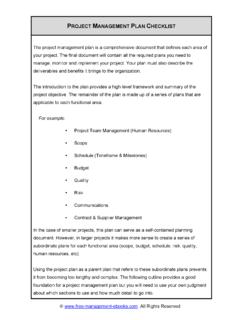Transcription of SWOT Analysis - Free Management eBooks
1 Team FMES trategy SkillsSWOT 978-1-62620-951-0 Copyright Notice 2013. All Rights ReservedISBN 978-1-62620-951-0 The material contained within this electronic publication is protected under International and Federal Copyright Laws and treaties, and as such any unauthorized reprint or use of this material is strictly may not copy, forward, or transfer this publication or any part of it, whether in elec-tronic or printed form, to another person, or or translation of any part of this work without the permission of the copy-right holder is against the downloading and use of this eBook requires, and is an indication of, your complete acceptance of these Terms of Use. You do not have any right to resell or give away part,or the whole, of this 978-1-62620-951-0 1 swot AnAlySiSTable of ContentsPreface 2 Visit Our Website 3 Introduction 4 swot Analysis 6 Importance of Clear Definitions 8 Internal Analysis 12 Strengths 13 Weaknesses 14 External Analysis 16 Opportunities 17 Threats 19 Matching and Converting 21 Advantages and Disadvantages 23 swot Analysis Example 24 Summary 29 Other Free Resources 30 References 31 ISBN 978-1-62620-951-0 2 swot AnAlySiSPrefaceThis eBook describes the swot Analysis , a technique that you can perform for products, services, and markets when deciding on the best strategy for achieving future will learn.
2 How swot can be used to guide strategy at the highest level or be tied to a spe-cific business objective How to identify internal factors including: organizational culture, expertise, re-sources, and unique qualities How to identify internal factors including the market and ecosystem How to use matching and converting when analyzing swot results The advantages and limitations of this popular and versatile Analysis methodISBN 978-1-62620-951-0 3 swot AnAlySiSVisit Our WebsiteMore free Management eBooks along with a series of essential templates and check-lists for managers are all available to download free of charge to your computer, iPad, or Amazon are adding new titles every month.
3 So don t forget to check our website regularly for the latest ISBN 978-1-62620-951-0 4 swot AnAlySiSintroductionToday s organizations find themselves operating in an environment that is changing faster than ever before. The process of analyzing the implications of these changes and modifying the way that the organization reacts to them is known as business strategy. Strategy is the direction and scope of an organization over the long term, which achieves advantage in a changing environment through its configura-tion of resources and competences Johnson et al. (2009).While your role as a manager is unlikely to require you to make decisions at the strategic level, you may be asked to contribute your expertise to meetings where strategic con-cerns are being discussed.
4 You may also be asked to comment on pilot schemes, presen-tations, reports, or statistics that will affect future SchemesPresentationsHow you participate in strategyStatisticsReportsWhether you work in a large multinational corporation or a small organization, a good understanding of the appropriate business Analysis techniques and terminology will help you to contribute to the strategic decision-making processes. ISBN 978-1-62620-951-0 5 swot Analysis Defi ning the strategy Internal capability to respond Implementation of the strategy External environmentAnalyzeAssessAidAssistTypical scenarios where you could be asked to provide information and data for your organization s strategic decision making include: Analyzing the organization s external environment.
5 Assessing the organization s internal capabilities and how well it can respond to external forces. Assisting with the definition of the organization s strategy. Aiding in the implementation of the organization s Defi nitionStrategic AnalysisStrategic PlanningInternal CapabilityExternal EnvironmentSWOT, AnsoffPESTLE, Porters 5 ForcesBoston BoxThe diagram above shows where five widely used business Analysis tools fit into the stra-tegic planning process. This series of eBooks will give you a solid understanding of how these tools can be used, as well as an appreciation of their 978-1-62620-951-0 6 swot AnAlySiSThis knowledge will enable you to take an active and productive role when asked to par-ticipate in the strategic decision-making process.
6 KEy POINTS 4 You may be asked to contribute your expertise to meetings where strategic concerns are being discussed. 4 Typical scenarios where you could be asked to provide information for stra-tegic decision making include: analyzing the organization s external environ-ment, assessing internal capabilities, assisting strategy definitions, and aiding in the AnalysisThe swot Analysis is a business Analysis technique that your organization can perform for each of its products, services, and markets when deciding on the best way to achieve future growth. The process involves identifying the strengths and weaknesses of the or-ganization, and opportunities and threats present in the market that it operates in. The first letter of each of these four factors creates the acronym OriginExternal OriginISBN 978-1-62620-951-0 7 swot AnAlySiSAs a manager, your role in any strategic planning is likely to involve providing operational data to help assess the internal capabilities, and (depending on your job function) you may also be asked to provide market intelligence.
7 The completion of a swot Analysis should help you to decide which market segments offer you the best opportunities for success and profitable growth over the life cycle of your product or service. swot AnalysisYour position against your competitorsIdentifi es best future opportunitiesHighlights current & future threatsThe swot Analysis is a popular and versatile tool, but it involves a lot of subjective deci-sion making at each stage. It should always be used as a guide rather than as a prescrip-tion and it is an iterative process. There is no such thing as a definitive swot for any particular organization because the strengths, weaknesses, opportunities, and threats depend to a large extent on the business objective under consideration.
8 This concept is described in detail later in this completing a swot Analysis , your organization will then use an Analysis tool such as the Ansoff Matrix to define the best growth strategy to achieve the chosen objective. If you are unfamiliar with the Ansoff Matrix or want to understand it in greater detail then visit our website and download our free Ansoff Matrix business strategy 978-1-62620-951-0 8 swot AnAlySiSKEy POINTS 4 swot Analysis provides information that helps in synchronizing an organiza-tion s resources and capabilities with the external environment in which the organization operates. 4 The acronym swot stands for Strengths, Weaknesses, Opportunities, and Threats.
9 4 Strengths and weaknesses are considered to be internal factors over which you have some measure of control. 4 Opportunities and threats are considered to be external factors over which you have no control. 4 SWOTs depend on the business objective under consideration. 4 There is NO definitive swot Analysis for any organization. 4 swot is often the first step in a more complex and in-depth of Clear DefinitionsBefore looking at how the swot Analysis can be applied to your organization, it is im-portant to be clear about what exactly we mean by the terms Strengths, Weaknesses, Opportunities, and Threats. Strengths Internal factors that are favorable for achieving your organiza-tion s Internal factors that are unfavorable for achieving your orga-nization s External factors that are favorable for achieving your orga-nization s External factors that are unfavorable for achieving your organiza-tion s definitions are open to interpretation and a weakness of the swot technique is that it can be highly subjective.
10 For example, if your organization was dependent on one single large distributor then this could be seen as a strength, as you would be able to get your products into the market quickly and efficiently. However, it could also be seen as a weakness because you are totally dependent on them to do 978-1-62620-951-0 9 swot AnAlySiSSome factors will always be easy to categorize. For example, it is difficult to imagine huge financial resources, a broad product line, no debt, and committed employees being any-thing other than strengths, whatever the objective of the organization may , some factors can be either strengths or weaknesses depending upon the busi-ness objective. For example, a large number of distributors could be a strength if your objective is to place your products in as many outlets as possible.


















